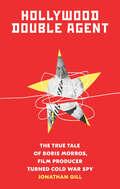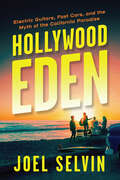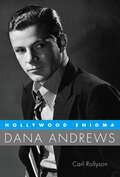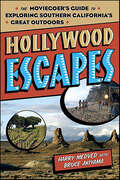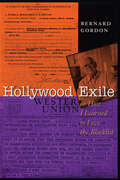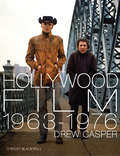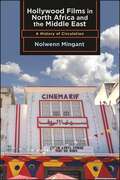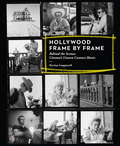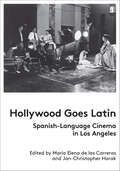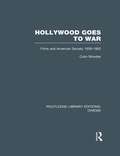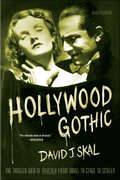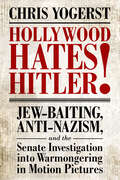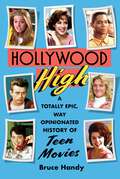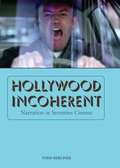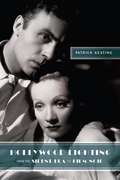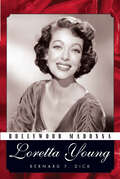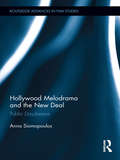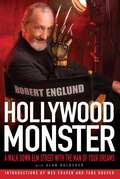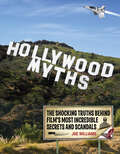- Table View
- List View
Hollywood Double Agent: The True Tale of Boris Morros, Film Producer Turned Cold War Spy
by Jonathan GillThis true story of Golden Age Hollywood and Cold War espionage is a “captivating, fast-paced narrative [that] reads like a thriller” (Library Journal). Boris Morros was a major figure in the 1930s and ’40s. The head of music at Paramount, nominated for Academy Awards, he then went on to produce his own films with Laurel and Hardy, Fred Astaire, Henry Fonda, and others. But as J. Edgar Hoover would discover, these successes were a cover for one of the most incredible espionage tales in the history of the Cold War—Boris Morros also worked for Russian intelligence.Morros’s assignments took him to the White House, the Vatican, and deep behind the Iron Curtain. The high-level intel he provided the KGB included military secrets and compromising information on prominent Americans: his friends. But in 1947, Morros flipped. At the height of the McCarthy era, he played a leading role in a deadly tale. Jonathan Gill’s Hollywood Double Agent is an extraordinary story about Russian spies at the heart of American culture and politics, and one man caught in the middle of the Cold War.“Well-written and perceptive . . . Morros was an empty vessel who could be turned left or right depending on how it satisfied his personal interest.” —New York Journal of Books“Reads like an espionage thriller . . . with malevolent, powerful—and sometimes bumbling—characters.” —Kirkus Reviews“A fascinating and swift-reading biography.” —The Wall Street Journal
Hollywood Eden: Electric Guitars, Fast Cars, and the Myth of the California Paradise
by Joel Selvin“Hollywood Eden brings the lost humanity of the record business vividly back to life … [Selvin’s] style is blunt, unpretentious and brisk; he knows how to move things along entertainingly … Songs about surfboards and convertibles had turned quaint, but in this book, their coolness is restored.” — New York Times From surf music to hot-rod records to the sunny pop of the Beach Boys, Jan & Dean, the Byrds, and the Mama’s & the Papa’s, Hollywood Eden captures the fresh blossom of a young generation who came together in the epic spring of the 1960s to invent the myth of the California Paradise. Central to the story is a group of sun-kissed teens from the University High School class of 1959 — a class that included Jan & Dean, Nancy Sinatra, and future members of the Beach Boys — who came of age in Los Angeles at the dawn of a new golden era when anything seemed possible. These were the people who invented the idea of modern California for the rest of the world. But their own private struggles belied the paradise portrayed in their music. What began as a light-hearted frolic under sunny skies ended up crashing down to earth just a few short but action-packed years later as, one by one, each met their destinies head-on. A rock ’n’ roll opera loaded with violence, deceit, intrigue, low comedy, and high drama, Hollywood Eden tells the story of a group of young artists and musicians who bumped heads, crashed cars, and ultimately flew too close to the sun.
Hollywood Enigma: Dana Andrews (Hollywood Legends Series)
by Carl RollysonDana Andrews (1909–1992) worked with distinguished directors such as John Ford, Lewis Milestone, Otto Preminger, Fritz Lang, William Wyler, William A. Wellman, Mervyn Le Roy, Jean Renoir, and Elia Kazan. He played romantic leads alongside the great beauties of the modern screen, including Joan Crawford, Elizabeth Taylor, Greer Garson, Merle Oberon, Linda Darnell, Susan Hayward, Maureen O'Hara, and most important of all, Gene Tierney, with whom he did five films. Retrospectives of his work often elicit high praise for an underrated actor, a master of the minimalist style. His image personified the “male mask” of the 1940s in classic films such as Laura, Fallen Angel, and Where the Sidewalk Ends, in which he played the “masculine ideal of steely impassivity.” No comprehensive discussion of film noir can neglect his performances. He was an “actor's actor.”Here at last is the complete story of a great actor, his difficult struggle to overcome alcoholism while enjoying the accolades of his contemporaries, a successful term as president of the Screen Actors Guild, and the love of family and friends that never deserted him. Based on diaries, letters, home movies, and other documents, this biography explores the mystery of a poor boy from Texas who made his Hollywood dream come true even as he sought a life apart from the limelight and the backbiting of contemporaries jockeying for prizes and prestige. Called “one of nature's noblemen” by his fellow actor Norman Lloyd, Dana Andrews emerges from Hollywood Enigma as an admirable American success story, fighting his inner demons and ultimately winning.
Hollywood Escapes: The Moviegoer's Guide to Exploring Southern California's Great Outdoors
by Harry Medved Bruce Akiyama“A perfect blend of show biz lore and wanderlust . . . Hollywood Escapes allows us to re-experience, in the flesh, the great escapism that movies provide.” —Brad Schreiber, Entertainment TodayLET THE MOVIES BE YOUR GUIDE!Hike THE TREASURE OF THE SIERRA MADRE Trail!Behold the KILL BILL Chapel!Enter THE DOORS Indian Caves!Swim at BEACH BLANKET BINGO's Malibu!Escape to SOME LIKE IT HOT's Resort!Raft the STAGECOACH River!Explore HIGH PLAIN DRIFTER's Ghostly Lake!Trek to the LOST HORIZON Waterfall!Discover the STAR WARS Sand Dunes!Here is the first comprehensive guide to Southern California's outdoor filming locations taking you to more than fifty of the Golden State's most cinematic beaches, mountains, deserts, lakes, hot springs and waterfalls. Illustrated with over one hundred scenic photos and twenty easy-to-read maps, Hollywood Escapes: The Moviegoer's Guide to Exploring Southern California's Great Outdoors not only takes you to movie history's most memorable destinations, but also recommends places to dine and lodge along the way, from mountain hideaways to beach side resorts.Written by inveterate movie buffs and outdoors enthusiasts Harry Medved and Bruce Akiyama, these two native Southern Californians have interviewed dozens of actors, filmmakers, location scouts and rangers to help you explore Hollywood's most spectacular scenery.“What a neat book! . . . a guidebook to Southern California that’s equal parts history, roadmap, restaurant guide, and pop culture catalogue.” —Leonard Maltin, New York Times–bestselling author of Leonard Maltin's Movie Guide
Hollywood Exile, or How I Learned to Love the Blacklist (Texas Film and Media Studies Series)
by Bernard GordonThe Hollywood blacklist, which began in the late 1940s and ran well into the 1960s, ended or curtailed the careers of hundreds of people accused of having ties to the Communist Party. Bernard Gordon was one of them. In this highly readable memoir, he tells a engrossing insider’s story of what it was like to be blacklisted and how he and others continued to work uncredited behind the scenes, writing and producing many box office hits of the era. Gordon describes how the blacklist cut short his screenwriting career in Hollywood and forced him to work in Europe. Ironically, though, his is a success story that includes the films El Cid, 55 Days at Peking, The Thin Red Line, Krakatoa East of Java, Day of the Triffids, Earth vs. the Flying Saucers, Horror Express, and many others. He recounts the making of many movies for which he was the writer and/or producer, with wonderful anecdotes about stars such as Charlton Heston, David Niven, Sophia Loren, Ava Gardner, and James Mason; directors Nicholas Ray, Frank Capra, and Anthony Mann; and the producer–studio head team of Philip Yordan and Samuel Bronston.
Hollywood Fantasies of Miscegenation: Spectacular Narratives of Gender and Race
by Susan CourtneyHollywood Fantasies of Miscegenation analyzes white fantasies of interracial desire in the history of popular American film. From the first interracial screen kiss of 1903, through the Production Code's nearly thirty-year ban on depictions of "miscegenation," to the contemplation of mixed marriage in Guess Who's Coming to Dinner (1967), this book demonstrates a long, popular, yet underexamined record of cultural fantasy at the movies. With ambitious new readings of well-known films like D.W. Griffith's 1915 epic The Birth of a Nation and of key forgotten films and censorship documents, Susan Courtney argues that dominant fantasies of miscegenation have had a profound impact on the form and content of American cinema. What does it mean, Courtney asks, that the image of the black rapist became a virtual cliché, while the sexual exploitation of black women by white men under slavery was perpetually repressed? What has this popular film legacy invited spectators to remember and forget? How has it shaped our conceptions of, and relationships to, race and gender? Richly illustrated with more than 140 images, Hollywood Fantasies of Miscegenation carefully attends to cinematic detail, revising theories of identity and spectatorship as it expands critical histories of race, sex, and film. Courtney's new research on the Production Code's miscegenation clause also makes an important contribution, inviting us to consider how that clause was routinely interpreted and applied, and with what effects.
Hollywood Film 1963-1976: Years of Revolution and Reaction
by Drew CasperHollywood 1963-1976 chronicles the upheaval and innovation that took place in the American film industry during an era of pervasive cultural tumult. Exploring the many ideologies embraced by an increasingly diverse Hollywood, Casper offers a comprehensive canon, covering the period's classics as well as its brilliant but overlooked masterpieces. A broad overview and analysis of one of American film's most important and innovative periods Offers a new, more expansive take on the accepted canon of the era Includes films expressing ideologies contrary to the misremembered leftist slant Explores and fully contextualizes the dominant genres of the 60s and 70s
Hollywood Films in North Africa and the Middle East: A History of Circulation (SUNY series, Horizons of Cinema)
by Nolwenn MingantDrawing on a broad range of primary sources, from trade and government publications to interviews, Hollywood Films in North Africa and the Middle East traces the circulation of Hollywood films across the region from the early twentieth century to the present. Originally introduced by French distributors, Hollywood films have been a key component of film culture in North Africa and the Middle East. These films became a favored mode of entertainment during the first half of the century as the major US film studios built a strong distribution structure. After World War II, the changing geopolitical context of decolonization pushed US distributors out of the market. Hollywood films, however, have continued to be favored by audiences. Today, in a landscape that also includes Egyptian and Indian films, Hollywood remains a relevant force in the region’s film culture, experienced by audiences in myriad ways from the pirate markets of North Africa to state-of-the-art theatres in the United Arab Emirates.
Hollywood Frame by Frame: Behind the Scenes: Cinema's Unseen Contact Sheets
by Karina LongworthThis is your illustrated invitation to the moments when movie history was made. Photographers' contact sheets are the permanent record of every shot that they took - and through Hollywood's golden age, there was often a photographer on set, capturing the scene as actors and directors collaborated to produce classic movies. This book collects the contact sheets from classic movies like The African Queen (1951), Some Like it Hot (1959), Taxi Driver (1976), Grosse Point Blank (1997) and many more. Capturing legends such as Woody Allen, Audrey Hepburn, Alfred Hitchcock, Marilyn Monroe, and Frank Sinatra at work and at repose, these images offer rare glimpses into the art of moviemaking, the science of movie marketing, and the nature of stardom.
Hollywood Genres: Formulas, Filmmaking and the Studio System
by Thomas SchatzHollywood Genres is divided into two parts. Part I is primarily theoretical, concerned in general terms with the essential characteristics and the cultural role of genre filmmaking. This section does not examine any individual genres or genre films, but looks at the very concept of what might be termed "genre-ness". Part II is composed of six chapters, each of which examines a dominant Hollywood genre: the Western, gangster, hardboiled detective, screwball comedy, musical, and family melodrama.
Hollywood Goes Latin: Spanish-Language Cinema in Los Angeles
by María Elena de las Carreras and Jan-Christopher HorakIn the 1920s, Los Angeles enjoyed a buoyant homegrown Spanish-language culture comprised of local and itinerant stock companies that produced zarzuelas, stage plays, and variety acts. After the introduction of sound films, Spanish-language cinema thrived in the city's downtown theatres, screening throughout the 1930s, 1940s, and 1950s in venues such as the Teatro Eléctrico, the California, the Roosevelt, the Mason, the Azteca, the Million Dollar, and the Mayan Theater, among others. With the emergence and growth of Mexican and Argentine sound cinema in the early to mid-1930s, downtown Los Angeles quickly became the undisputed capital of Latin American cinema culture in the United States. Meanwhile, the advent of talkies resulted in the Hollywood studios hiring local and international talent from Latin America and Spain for the production of films in Spanish. Parallel with these productions, a series of Spanish-language films were financed by independent producers. As a result, Los Angeles can be viewed as the most important hub in the United States for the production, distribution, and exhibition of films made in Spanish for Latin American audiences. In April 2017, the International Federation of Film Archives organized a symposium, "Hollywood Goes Latin: Spanish-Language Cinema in Los Angeles," which brought together scholars and film archivists from all of Latin America, Spain, and the United States to discuss the many issues surrounding the creation of Hollywood's "Cine Hispano." The papers presented in this two-day symposium are collected and revised here.This is a joint publication of FIAF and UCLA Film & Television Archive.
Hollywood Goes Oriental: CaucAsian Performance in American Film
by Tom Gunning Karla Rae FullerAn in-depth look at the portrayal of Asian characters by non-Asian actors in classical Hollywood film.
Hollywood Goes to War: Films and American Society, 1939-1952 (Routledge Library Editions: Cinema)
by Colin ShindlerA historian’s view of the relationship between American history and the American film industry, this book is a witty and perceptive account of Hollywood and its films in the years from the outbreak of the Second World War in Europe to the end of the war in Korea, It describes how film makers and their industry were shaped by and responded to the strong political and social stimuli of wartime America. The author examines the recurring question of whether the movies were a reflection of the society in which they were produced, or whether by virtue of their undeniable propaganda power the films shaped that society. Combining evidence from literary, visual and oral sources, he covers a wide range of movies, emphasising in particular Casablanca, Mrs Miniver, The Best Years of Our Lives and Since You Went Away. In addition to placing the films in a social and political context, the author shows that Hollywood is a perfect example of the bone-headed way in which people behave when they are dealing with large amounts of money and power. Enjoyably nostalgic, this book will appeal to film enthusiasts as well as those interested in war and its effect on society.
Hollywood Gothic: The Tangled Web of Dracula from Novel to Stage to Screen
by David J. SkalA fully updated edition of David J. Skal's Hollywood Gothic, "The ultimate book on Dracula" (Newsweek).The primal image of the black-caped vampire Dracula has become an indelible fixture of the modern imagination. It's recognition factor rivals, in its own perverse way, the familiarity of Santa Claus. Most of us can recite without prompting the salient characteristics of the vampire: sleeping by day in its coffin, rising at dusk to feed on the blood of the living; the ability to shapeshift into a bat, wolf, or mist; a mortal vulnerability to a wooden stake through the heart or a shaft of sunlight. In this critically acclaimed excursion through the life of a cultural icon, David J. Skal maps out the archetypal vampire's relentless trajectory from Victorian literary oddity to movie idol to cultural commodity, digging through the populist veneer to reveal what the prince of darkness says about us all.includes black-and-white Illustrations throughout, plus a new Introduction.
Hollywood Hates Hitler!: Jew-Baiting, Anti-Nazism, and the Senate Investigation into Warmongering in Motion Pictures
by Chris YogerstIn September 1941, a handful of isolationist senators set out to tarnish Hollywood for warmongering. The United States was largely divided on the possibility of entering the European War, yet the immigrant moguls in Hollywood were acutely aware of the conditions in Europe. After Kristallnacht (the Night of Broken Glass), the gloves came off. Warner Bros. released the first directly anti-Nazi film in 1939 with Confessions of a Nazi Spy. Other studios followed with such films as The Mortal Storm (MGM), Man Hunt (Fox), The Man I Married (Fox), and The Great Dictator (United Artists). While these films represented a small percentage of Hollywood’s output, senators took aim at the Jews in Hollywood who were supposedly “agitating us for war” and launched an investigation that resulted in Senate Resolution 152. The resolution was aimed at both radio and movies that “have been extensively used for propaganda purposes designed to influence the public mind in the direction of participation in the European War.” When the Senate approved a subcommittee to investigate the intentions of these films, studio bosses were ready and willing to stand up against the government to defend their beloved industry. What followed was a complete embarrassment of the United States Senate and a large victory for Hollywood as well as freedom of speech. Many works of American film history only skim the surface of the 1941 investigation of Hollywood. In Hollywood Hates Hitler! Jew-Baiting, Anti-Nazism, and the Senate Investigation into Warmongering in Motion Pictures, author Chris Yogerst examines the years leading up to and through the Senate Investigation into Motion Picture War Propaganda, detailing the isolationist senators’ relationship with the America First movement. Through his use of primary documents and lengthy congressional records, Yogerst paints a picture of the investigation’s daily events both on Capitol Hill and in the national press.
Hollywood High: A Totally Epic, Way Opinionated History of Teen Movies
by Bruce HandyFrom a longtime Vanity Fair writer and editor, a delightfully entertaining, intelligent, and illuminating history and tribute to teen movies—from Rebel Without a Cause to Fast Times at Ridgemont High, and on to John Hughes, Mean Girls, The Hunger Games, and more.What influence did Francis Ford Coppola have on George Lucas&’s American Graffiti? And Lucas on John Singleton&’s Boyz n the Hood? How does teenage sexuality in Fast Times at Ridgemont High compare to Twilight? Which teen movies pass the Bechdel test? Why is Mean Girls actually the last great teen film of the 20th century? In the same way that Peter Biskind&’s Easy Riders, Raging Bulls connects the films of the 1970s to the period&’s cultural upheaval, and David Hadju&’s Positively 4th Street tells the story of the sixties through the emergence of folk music, Bruce Handy&’s Hollywood High situates iconic teen movies within their times and reveals the intriguing stories, artists, and passions behind their creation. These films aren&’t merely beloved stories; they reflect teens&’ growing economic and cultural influence, societal panics, and shifting perceptions of youth in America. Much more than a nostalgia trip, Hollywood High is a lively, provocative, and affectionate cultural history, spanning nearly one hundred years. Handy, an acclaimed journalist and critic who spent two decades at Vanity Fair, examines the defining films of each generation and builds connections between them. From the Andy Hardy classics (1937–1946) to the iconic Rebel Without a Cause (1955); Beach Party series (1963–1968); American Graffiti (1973); Fast Times at Ridgemont High (1982); the John Hughes touchstones Sixteen Candles, The Breakfast Club, Pretty in Pink, and Ferris Bueller&’s Day Off (1984–1986); Boyz N the Hood (1991); Mean Girls (2004); the Twilight saga (2008–2012); and The Hunger Games series (2012–2015); this is a captivating deep dive into the world of teen movies that captures their sweeping history and influence. We&’ll hear from icons James Dean, Annette Funicello, George Lucas, Amy Heckerling, John Hughes, Molly Ringwald, John Singleton, Tina Fey, and Kristen Stewart, and discover why the most timeless teen movies resonate across generations.
Hollywood Hoofbeats
by Audrey Pavia Petrine Day MitchumPetrine Day Mitchum tells stories in page-turning detail, covering topics such as behind-the-scenes portraits of both famous movie horses and those virtually unknown; personal accounts from their trainers, owners, and co-stars; simple and complex horse stunts, from a fall in mid-gallop to a race across a bridge during a live explosion; and historic black-and-white photographs and richly coloured contemporary stills.
Hollywood Hoofbeats
by Audrey Pavia Petrine Day MitchumThe horses that captured the moviegoers' hearts are the common denominator in Hollywood Hoofbeats. As author Petrine Day Mitchum writes, "the movies as we know them would be vastly different without horses. There would be no Westerns-no cowboy named John Wayne-no Gone with the Wind, no Ben Hur, no Dances with Wolves..." no War Horse, no True Grit, no Avatar! Those last three 21st-century Hollywood creations are among the new films covered in this expanded second edition of Hollywood Hoofbeats written by the daughter of movie star Robert Mitchum, who himself appeared on the silver screen atop a handsome chestnut gelding. Having grown up around movie stars and horses, Petrine Day Mitchum is the ideal author to pay tribute to the thousands of equine actors that have entertained the world since the inception of the film medium.From the early days of D.W. Griffith's The Great Train Robbery to Quentin Tarantino's Django Unchained, this celebration of movies promises something for every Hollywood fan... the raucous comedy of Abbot and Costello (and "Teabiscuit") in It Ain't Hay, a classic sports films like National Velvet starring Elizabeth Taylor, a timeless epic with Errol Flynn, and films featuring guitar-strumming cowboys like Gene Autry and Roy Rogers.INSIDE HOLLYWOOD HOOFBEATSMovie trivia and fascinating anecdotes about the stars of yesterday and todayAn inside look at the stunts horses performed in motion pictures and the lingering controversiesHundreds of illustrations, including rare movie posters, movie stills, and film clipsUpdated, expanded text including coverage of new movies and photographsChapters devoted to action films, Westerns, comedies, musicals, child stars, and moreFamous TV programs and their horses including Mr. Ed and Silver (Lone Ranger)
Hollywood Incoherent: Narration in Seventies Cinema
by Todd BerlinerIn the 1970s, Hollywood experienced a creative surge, opening a new era in American cinema with films that challenged traditional modes of storytelling. Inspired by European and Asian art cinema as well as Hollywood’s own history of narrative ingenuity, directors such as Martin Scorsese, Robert Altman, William Friedkin, Stanley Kubrick, Woody Allen, and Francis Ford Coppola undermined the harmony of traditional Hollywood cinema and created some of the best movies ever to come out of the American film industry. Critics have previously viewed these films as a response to the cultural and political upheavals of the 1970s, but until now no one has explored how the period’s inventive narrative design represents one of the great artistic accomplishments of American cinema. In Hollywood Incoherent, Todd Berliner offers the first thorough analysis of the narrative and stylistic innovations of seventies cinema and its influence on contemporary American filmmaking. He examines not just formally eccentric films—Nashville; Taxi Driver; A Clockwork Orange; The Godfather, Part II; and the films of John Cassavetes—but also mainstream commercial films, including The Exorcist, The Godfather, The French Connection, Willy Wonka and the Chocolate Factory, Dog Day Afternoon, Chinatown, The Bad News Bears, Patton, All the President’s Men, Annie Hall, and many others. With persuasive revisionist analyses, Berliner demonstrates the centrality of this period to the history of Hollywood’s formal development, showing how seventies films represent the key turning point between the storytelling modes of the studio era and those of modern American cinema.
Hollywood Lighting from the Silent Era to Film Noir
by Patrick KeatingLighting performs essential functions in Hollywood films, enhancing the glamour, clarifying the action, and intensifying the mood. Examining every facet of this understated art form, from the glowing backlights of the silent period to the shaded alleys of film noir, Patrick Keating affirms the role of Hollywood lighting as a distinct, compositional force. Closely analyzing Girl Shy (1924), Anna Karenina (1935), Only Angels Have Wings (1939), and T-Men (1947), along with other brilliant classics, Keating describes the unique problems posed by these films and the innovative ways cinematographers handled the challenge. Once dismissed as crank-turning laborers, these early cinematographers became skillful professional artists by carefully balancing the competing demands of story, studio, and star. Enhanced by more than one hundred illustrations, this volume counters the notion that style took a backseat to storytelling in Hollywood film, proving that the lighting practices of the studio era were anything but neutral, uniform, and invisible. Cinematographers were masters of multifunctionality and negotiation, honing their craft to achieve not only realistic fantasy but also pictorial artistry.
Hollywood Lighting from the Silent Era to Film Noir (Film and Culture Series)
by Patrick KeatingLighting performs essential functions in Hollywood films, enhancing the glamour, clarifying the action, and intensifying the mood. Examining every facet of this understated art form, from the glowing backlights of the silent period to the shaded alleys of film noir, Patrick Keating affirms the role of Hollywood lighting as a distinct, compositional force.Closely analyzing Girl Shy (1924), Anna Karenina (1935), Only Angels Have Wings (1939), and T-Men (1947), along with other brilliant classics, Keating describes the unique problems posed by these films and the innovative ways cinematographers handled the challenge. Once dismissed as crank-turning laborers, these early cinematographers became skillful professional artists by carefully balancing the competing demands of story, studio, and star. Enhanced by more than one hundred illustrations, this volume counters the notion that style took a backseat to storytelling in Hollywood film, proving that the lighting practices of the studio era were anything but neutral, uniform, and invisible. Cinematographers were masters of multifunctionality and negotiation, honing their craft to achieve not only realistic fantasy but also pictorial artistry.
Hollywood Madonna: Loretta Young (Hollywood Legends Series)
by Bernard F. DickLoretta Young (1913–2000) was an Academy Award–winning actress known for devout Catholicism and her performances in The Farmer's Daughter, The Bishop's Wife, and Come to the Stable, and for her long-running and tremendously popular television series. But that was not the whole story.. Hollywood Madonna explores the full saga of Loretta Young's professional and personal life. She made her film debut at age four, became a star at fifteen, and many awards and accolades later, made her final television movie at age seventy-six. This biography withholds none of the details of her affair with Clark Gable and the daughter that powerful love produced. Bernard F. Dick places Young's affair in the proper context of the time and the choices available to women in 1935, especially a noted Catholic like Young, whose career would have been in ruins if the public knew of her tryst. With the birth of a daughter, who would have been branded a love child, Loretta Young reached the crossroads of disclosure and deception, choosing the latter path. That choice resulted in an illustrious career for her and a tortured childhood for her daughter.
Hollywood Melodrama and the New Deal: Public Daydreams (Routledge Advances in Film Studies)
by Anna SiomopoulosWhile many critics have analyzed the influence of the FDR administration on Hollywood films of the era, most of these studies have focused either on New Deal imagery or on studio interactions with the federal government. Neither type of study explores the relationship between film and the ideological principles underlying the New Deal. This book argues that the most important connections between the New Deal and Hollywood melodrama lie neither in the New Deal iconography of these films, nor in the politics of any one studio executive. Rather, the New Deal figures prominently in Hollywood melodramas of the Depression era because these films engage the political ideas underlying welfare state policies—ideas that extended the reach of government into the private realm. As the author shows, Hollywood melodramas interrogated New Deal principles of liberal empathy—consumer citizenship, the refeudalization of the state, and minimal economic redistribution—only to support welfare-state ideology in the end.
Hollywood Monster: A Walk Down Elm Street with the Man of Your Dreams
by Alan Goldsher Robert EnglundRobert Englund, legendary star of A Nightmare on Elm Street, peels back the Freddy Krueger mask and reveals the stuff of every horror buff&’s dreams.ONE...TWO...FREDDY'S COMING FOR YOU... You've seen him in the A Nightmare on Elm Street series—and in your darkest dreams. The sadistic killer with the flame-charred face. The knife-blade claws. The razor-sharp wit. Freddy...But you've never seen him like this. Unflinching. Uncensored. Unmasked. Meet Robert Englund, the award-winning actor best known for his role as Freddy Krueger—the legendary horror icon featured on the American Film Institute's "100 Greatest Heroes and Villains" roster—a character as unforgettable and enduring as Bela Lugosi's Dracula and Boris Karloff's Frankenstein. Now, for the first time, the man behind the latex mask tells his story in this captivating new memoir, published to celebrate the twenty-fifth anniversary of the first A Nightmare on Elm Street film. You see, Robert Englund is no monster at all, but a deeply funny, charming Hollywood veteran. Packed with Robert's hilarious stories, playful self-deprecation, and a generous helping of never-before-revealed A Nightmare on Elm Street trivia, Hollywood Monster offers an unparalleled look at the beloved film icon. With insider savvy and gallows humor, Robert recounts his audition for Wes Craven, the inspiration for Freddy's character, the grueling makeup sessions, his soon-to-be-famous costars, the often disastrous on-set blunders, and the wave of popularity that propelled this humble California surfer kid all the way to the top. Of course, fame and fortune as Freddy came years after the young actor shared a trailer with screen legend Henry Fonda, was punched in the face by Richard Gere, took down Burt Reynolds, and muscled his way between Arnold Schwarzenegger, Sally Field, and Jeff Bridges. But soon after his high-profile stint in the groundbreaking TV miniseries V, Robert Englund took on the most celebrated role of his career—the macabre and wisecracking killer who quickly became a household name. From the moment Freddy Krueger dragged his claws across a rusty pipe in the opening dream sequence, a legend had been unleashed—and a star was born. This is his story. "Welcome to prime time, bitch." —Frederick Charles Krueger, bastard son of a hundred maniacs
Hollywood Myths: The Shocking Truths Behind Film's Most Incredible Secrets and Scandals
by Joe WilliamsA film journalist’s insider account of the truth behind some of the movie industry’s biggest legends and scandals—a perfect gift for film buffs.Hollywood exists to create and sell myth. Often, however, the myths created on screen are secondary to the rumors, half-truths, and lies that circulate through studio back lots and the press. Discover the real stories behind Hollywood’s greatest myths, as veteran film critic and Hollywood reporter Joe Williams sorts fact from fiction and examines how these tales came to be and how they persisted. Did Thomas Edison really invent the motion picture? Why has Charlie Chaplin survived as the undisputed king of the silent era? What about Fatty Arbuckle and that ill-fated boys’ weekend in San Francisco? Did Woody Allen really marry his adopted daughter? Was there actually a suicide on the set of The Wizard of Oz (or are any of the other countless rumors about that film true)? The tales featured in Hollywood Myths involve specific films, actors’ private lives, the industry itself, and urban legends that have existed as long as Hollywood has. Throughout, Williams illuminates what it was that made the biggest stars—from Marlon to Marilyn, Bogie to Brad—shine so brightly on the silver screen. In all, 56 enduring myths are examined, in the process revealing the machinations of myth-making in the fast, loose, and out-of-control world of Hollywood.
